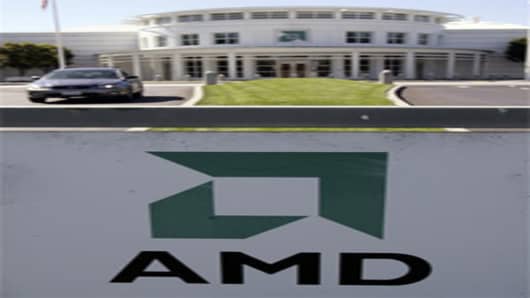With today's 6 percent move to the downside for Advanced Micro Devices, falling below $5 a share, the company's stock now sits at a 16-year-low.
Its chief rival, Intel Corp., creates AMD'sentire market cap every three weeks or so.
We make so much of the rivalry between the two, but AMD is quickly becoming an asterisk in the broader market, and the company's chief executive, Hector Ruiz, continues to hold power.
You just have to wonder for how long. This was a $16 stock a year ago; $23 a share a year before that. This slide has been consistent, precipitous, and there's no end in sight for these shares to turn around.
The latest bit of devastating news for AMD comes from the animated studio DreamWorks, the folks behind "Kung Fu Panda," "Shrek," and so many other animated hits, deciding on new chips from Intel to help the studio along with its 3D animation efforts, rather than continuing its relationship with AMD. AMD and DreamWorks have partnered since 2005 and was a lucrative deal for AMD: DreamWorks boasts 1,000 workstations and 1,500 servers.
Last year, I focused on AMD and its initiatives in Hollywood, partnering with major studios, including Lucas Film, because of the speed and price of its server and desktop chips. In fact, AMD spotlighted its relationship with Hollywood as a great example of the kinds of innovations its microprocessors could fuel in the right hands. A way to give consumers and companies a glimpse at what's possible with technology from AMD. Animated movies already use enormous computing power, but the 3D aspect of movie-making requires twice even that level of computing. Distressing for AMD is the message this news sends: that AMD chips were acceptable, to a point; but that now that films are getting more complicated, and need even more power, DreamWorks decided to go elsewhere.
AMD might be running out of options. The company has already sold an 8.1 percent chunk of itself to the Abu Dhabi government last September, but with a dramatically shrinking cap-ex budget, AMD appears unable to spend its way out of this mess. Some will say that AMD's problems stemmed from its acquisition of graphics chip maker ATI Technologies a couple of years ago for what was then thought to be a heavily inflated $5.4 billion. AMD had enormous trouble trying to digest that deal and now its value almost twice AMD's dwindling market cap. Ouch.
This is a company literally fighting for its life, and it needs to survive. Consumers, business customers, the marketplace as a whole need this company to survive. Intel is a well-oiled, money-making machine, but as the only game in town, it runs the risk of being a monopolist in more than just "name only." AMD has made the argument, sometimes compelling, sometimes not, that Intel has spent decades exercising that monopoly power.
There may be some fire under all that smoke, but in the meantime the industry still has two competitors. If Ruiz and team can't figure out a way to strengthen AMD, after so much time trying, they should step aside and make way for a team that can. More is at stake here than merely the survival of AMD as a company; chip industry competition depends on it.
AMD reports earnings a week from today. Two days after Intel.
Questions? Comments? TechCheck@cnbc.com


